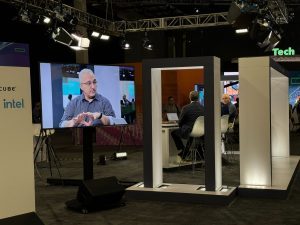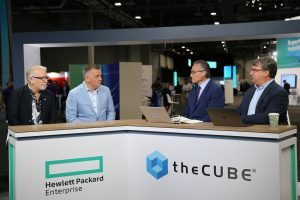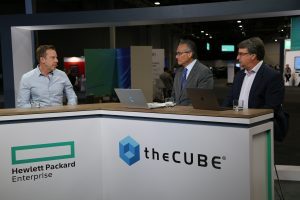HPE AI solutions at Discover: Enterprise adoption insights – Business
Artificial intelligence took center stage at HPE Discover last week. For three days, company executives captivated audiences with keynote sessions focused on Hewlett Packard Enterprise Co.’s cutting-edge AI solutions and the robust infrastructure it’s building to support them.
New solutions for AI deployment and how HPE’s enterprise customers can take advantage of them were discussed at length by theCUBE, SiliconANGLE Media’s livestreaming studio, through interviews with company executives, clients and industry analysts at HPE’s signature event. TheCUBE’s interviews included Antonio Neri (pictured), president and chief executive officer of HPE, who outlined the challenges for AI adoption during his keynote remarks. (* Disclosure below.)
“I thought that was one of the strongest parts of Antonio’s keynote, where he said AI is hard and it’s full of risks,” said Dave Vellante, chief analyst at theCUBE Research, in a post-keynote analysis during the event. “He said they’ve been working on this five-point model framework. It’s got to be private. It’s got to be human focused. It’s got to be access for all. It’s got to be responsible. It’s got to be robust and tested in an ongoing way.”
Here’s theCUBE’s complete analysis from Dave Vellante, who was joined by fellow analysts John Furrier and Rebecca Knight:
Check out these three essential insights you may have missed during the event:
1. HPE is leaning in on simplicity and accessibility for AI deployment.
Neri’s point about AI being hard has shaped his company’s work in developing AI solutions. The goal is to make sophisticated AI tools as accessible and manageable as possible for enterprise customers.

HPE’s Antonio Neri talks with theCUBE about HPE AI solutions during HPE Discover 2024.
To this end, Neri announced HPE’s Private Cloud AI offering with Nvidia Corp.’s Chief Executive Jensen Huang during the opening day of the conference and emphasized a focus on minimal complexity and maximum efficiency.
“What we did yesterday with Jensen [Huang] is to deliver the amazing innovation that he has with amazing innovation HPE has in one integrated experience and leverage that unified platform, called HPE GreenLake, to deploy [in] three clicks … 24 seconds,” said Neri, during his exclusive interview on theCUBE. “We’re going to show up as one company selling the same thing.”
Watch theCUBE’s complete video interview with Antonio Neri.
HPE’s Private Cloud AI solution was characterized by the company as a turnkey approach, an AI offering orchestrated to be seamlessly integrated into enterprise operations and tailored for businesses of all sizes.
“Our [AI solution is] already pre-integrated, pre-tested, and it’s ready to roll in the four sizes that we have and easily expandable,” said Jason Newton, vice president of integrated marketing, events and messaging at HPE, in conversation with theCUBE.
Here’s theCUBE’s complete video interview with Jason Newton, who was joined by Jim Jackson, chief marketing officer of HPE:
This message of simplicity provided HPE with an opportunity to extol the virtues of GreenLake, its hybrid cloud platform designed to deploy and manage resources across public and private infrastructure. Private Cloud AI will be enabled by GreenLake, part of HPE’s ongoing effort to help customers centralize operations in a single platform.
“Since cloud adoption has started, the reality is that the businesses, the enterprises have struggled to gain the cloud economics across the complete suite of their workloads,” said Tony Koinov, senior vice president and general manager of the GreenLake platform at HPE, during a discussion on theCUBE. “We have built from the ground up a platform-first cloud experience for them so that we are providing a single cloud, for their multivendor, multicloud estate … a single platform that rings common data, common services, common practices across all of their infrastructure.”
Here’s theCUBE’s complete video interview with Tony Koinov, who was joined by Latha Vishnubhotla, chief platform officer of HPE:
2. Nvidia is making its case for a prominent role in the enterprise market.
The partnership between Nvidia and HPE that was unveiled during the Discover gathering in Las Vegas offered insight into the chipmaker’s enterprise interest.

Nvidia’s Bob Pette and HPE’s Neil MacDonald discuss their AI partnership.
Nvidia’s announcement of a new, microservices-based layer for its Nvidia AI Enterprise platform earlier this year underscored its pursuit of the lucrative enterprise computing market. The enhancements included NIM microservices to enable optimized inference of popular generative AI models.
“We have a slew of models covering a variety of enterprise use cases across multiple industries, which is what [CEO] Jensen refers to as the next industrial revolution,” said Bob Pette, vice president and general manager of enterprise platforms at Nvidia, during an appearance on theCUBE. “We’re actually able to take multiple data sources and predict, and that’s where more and more intelligence is extracted … these NIMs, these containerized models can come from anywhere. People can download them from wherever they are, but we have a nightly NIM AI factory at Nvidia that we continue to build these models, tune, test, optimize.”
The application of a containerized infrastructure for model processing is a glimpse into the future of AI architecture, where enterprises can integrate both data and model stacks for greater efficiency and cost savings.
“The architecture is not about the individual nodes anymore. It’s not even about the individual accelerators anymore,” said Neil MacDonald, executive vice president and general manager of the Compute Business Unit at HPE, who joined Pette in conversation on theCUBE. “It’s about the whole system architecture that brings together all of the capabilities in that compute stack, the data stack and the model stack that you need to be effective with generative AI. So, another shift here, both for our partnership and our collaboration but also for our enterprise customers, is thinking at that system level in a much, much more profound and cohesive way.”
Watch theCUBE’s complete video interview with Bob Pette and Neil MacDonald.
As Nvidia builds a presence in the enterprise and other market sectors, the company is maximizing its capabilities to power cloud and on-premises environments. This is why the partnership with HPE makes a great deal of sense, according to Holger Mueller, principal analyst at Constellation Research Inc., during an AnalystANGLE segment on theCUBE.
“If you think about Nvidia, they don’t have enterprise expertise,” Mueller said. “This is all happening recently, and all the interest coming in is from the cloud hyperscaler side — which doesn’t give them the enterprise expertise either. So, who is a good partner for [them], who has a long-term enterprise history and an install base … who knows how to build complex systems?”
Here’s theCUBE’s complete video interview with Holger Mueller:
3. Key enterprise players are retooling infrastructure to meet AI needs without having to rebuild from scratch.
While AI has experienced remarkable advances in a short period of time, it quickly became apparent that systems infrastructure needed to catch up. Companies such as Intel Corp. are working with clients to find optimal ways to integrate AI into existing computing architectures.

Intel’s Brett Hannath talks with theCUBE about processors for AI.
“What we’re trying to do is bring AI compute power into architectures people already understand, know and use today,” according to Brett Hannath, corporate vice president and chief marketing officer of Intel, during a conversation with theCUBE. “Rather than having to go retrain all these infrastructure teams that you talked about, you can actually leverage the architectures that you have today. We really are just trying to play that role in the AI space so it’s not just the high end with the people with the large wallets.”
Watch theCUBE’s complete video interview with Brett Hannath.
One way that Intel is seeking to help customers transition to the optimal infrastructure is by providing elasticity through new chiplet designs, such as P-core or E-core processors that are focused on large AI workloads.
“The chiplet technology allows you to intersperse and choose the right node for the right technology,” said Ryan Tabrah, vice president and general manager of Xeon E-Core products at Intel, during an interview on theCUBE. “Workloads will drive the software. The software will drive how the data center is built. The data center build will drive how the rack is built, which then we just have to have the products there that unleash all of these customers’ innovative ideas to use AI for awesome things.”
Watch theCUBE’s complete video interview with Ryan Tabrah.
In a quest to find the optimal AI infrastructure, enterprises have begun to expand data center capacity. Chief technology officers at many firms are now saying they are purchasing more data center space for the first time in over 10 years, according to Zeus Kerravala, founder and principal analyst at ZK Research, during an appearance on theCUBE. This could soon lead to a pullback in spending
“You’ve got a lot of conflicting forces, in trying to save money, in trying to be more sustainable,” Kerravala said. “But I’m buying more AI, and I’m buying more data center space, and something’s got to give. I’m concerned we’re going to see that in the back half of the year.”
Here’s theCUBE’s complete video interview with Zeus Kerravala:
To watch more of theCUBE’s coverage of HPE Discover, here’s our complete event video playlist:
https://www.youtube.com/watch?v=videoseries
(* Disclosure: TheCUBE is a paid media partner for HPE Discover. Neither HPE and Intel Corp., the primary sponsors of theCUBE’s event coverage, nor other sponsors have editorial control over content on theCUBE or SiliconANGLE.)
